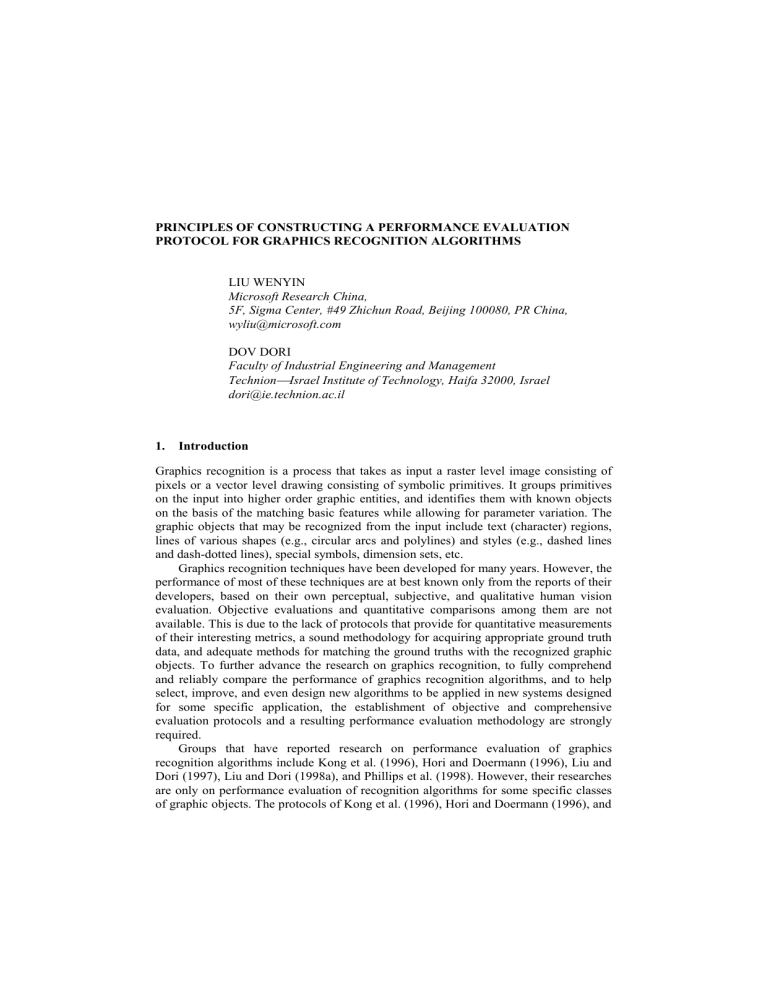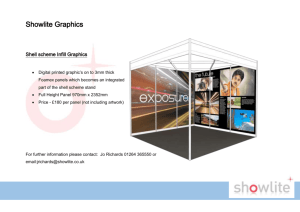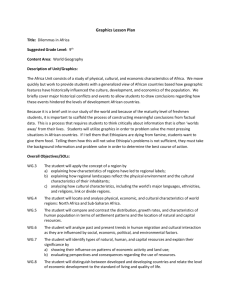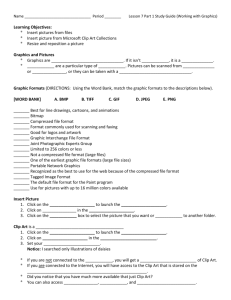2. The Performance Evaluation Protocol

PRINCIPLES OF CONSTRUCTING A PERFORMANCE EVALUATION
PROTOCOL FOR GRAPHICS RECOGNITION ALGORITHMS
LIU WENYIN
Microsoft Research China,
5F, Sigma Center, #49 Zhichun Road, Beijing 100080, PR China, wyliu@microsoft.com
DOV DORI
Faculty of Industrial Engineering and Management
Technion
Israel Institute of Technology, Haifa 32000, Israel dori@ie.technion.ac.il
1.
Introduction
Graphics recognition is a process that takes as input a raster level image consisting of pixels or a vector level drawing consisting of symbolic primitives. It groups primitives on the input into higher order graphic entities, and identifies them with known objects on the basis of the matching basic features while allowing for parameter variation. The graphic objects that may be recognized from the input include text (character) regions, lines of various shapes (e.g., circular arcs and polylines) and styles (e.g., dashed lines and dash-dotted lines), special symbols, dimension sets, etc.
Graphics recognition techniques have been developed for many years. However, the performance of most of these techniques are at best known only from the reports of their developers, based on their own perceptual, subjective, and qualitative human vision evaluation. Objective evaluations and quantitative comparisons among them are not available. This is due to the lack of protocols that provide for quantitative measurements of their interesting metrics, a sound methodology for acquiring appropriate ground truth data, and adequate methods for matching the ground truths with the recognized graphic objects. To further advance the research on graphics recognition, to fully comprehend and reliably compare the performance of graphics recognition algorithms, and to help select, improve, and even design new algorithms to be applied in new systems designed for some specific application, the establishment of objective and comprehensive evaluation protocols and a resulting performance evaluation methodology are strongly required.
Groups that have reported research on performance evaluation of graphics recognition algorithms include Kong et al. (1996), Hori and Doermann (1996), Liu and
Dori (1997), Liu and Dori (1998a), and Phillips et al. (1998). However, their researches are only on performance evaluation of recognition algorithms for some specific classes of graphic objects. The protocols of Kong et al. (1996), Hori and Doermann (1996), and
Liu and Dori (1997) are aimed at performance evaluation of line detection algorithms.
Liu and Dori (1998a) propose a protocol for text segmentation evaluation. Phillips et al.
(1998) propose a performance evaluation protocol for engineering drawings recognition systems, which includes performance evaluation of both line detection and text segmentation capabilities. There is no common methodology that abstracts the performance genericity of graphics recognition algorithms and can be generally applied to their performance evaluation.
Based on the observed genericity of graphics recognition (Ablameyko 1996, Liu and Dori 1998b), we propose a methodology for performance evaluation of graphics recognition algorithms. The methodology materializes an objective-driven evaluation philosophy that is based on definitions of a matching degree and comprehensive performance metrics.
2.
The Performance Evaluation Protocol
We view the performance as a set of metrics of interest on the output data that a system implementing a set of one or more algorithms produces with respect to the expected, ground truth data. Usually, the metrics are expressed in terms of the difference between the expected output and the actual output of the system. The metrics should be represented by quantitative indices based on accepted definitions to avoid subjectivity.
Moreover, the entire performance of an algorithm should be reflected by a comprehensive metric. Appropriate analysis of relevant metrics should help compare, select, improve, and even design new methods to be applied in new systems targeted at specific applications.
To evaluate the performance of a graphics recognition algorithm, we need three elements. First of all, we need to know the expected output—the ground truth—such that it can be compared with the actual output—the recognition results. Therefore, a sound methodology of acquiring the appropriate ground truth data is required. Secondly, Since both the ground truth data and the recognition results consist of many graphic objects, individual comparison of each ground truth object to its matching recognized object should be done in the first place. To do this, each ground truth graphic object must first be matched with one or more objects from the recognized objects set. Hence, a sound matching method is needed. Finally, representative metrics of interest should be selected, and quantitative indices that measure these metrics should be defined uniformly. In summary, the three essential performance evaluation elements are (1) ground truth acquisition; (2) matching procedure; and (3) quantitative metrics definition.
A performance evaluation protocol for a graphics recognition system therefore consists of these three parts.
While the ground truth acquisition methodology is widely accepted, the definitions of matching between ground truth objects and recognized ones, as well as the selection of the appropriate performance metrics are still controversial issues. In this sense, standards based on large amount of experiments, including the evaluation of performance evaluation protocols themselves, are strongly needed. A complete and reasonable evaluation protocol should be objective, comprehensive, and should include specific indices and an overall index of the algorithm performance. The three
performance evaluation protocol elements are respectively discussed in detail in the following three sections.
3.
Ground Truth Acquisition
Ground truth acquisition is the process that generates both the actual input for the evaluated system and the expected output (ground truth) for comparison with the actual output. To comprehensively and thoroughly evaluate an algorithm on real-life drawings, real-life ground truth is highly desirable. However, this type of ground truth is hard to obtain, as it requires manual measurements, which are labor intensive and error-prone.
Moreover, manual ground truth input is somewhat subjective and may vary from one human to another. However, this seems to be the only method to acquire the ground truth for real-life input drawings. This is so since if we would have been able to find an automatic way to obtain the ground truth of real life inputs, it would be the ultimate graphics recognition algorithm, making any other algorithm useless. While large amount of manual work is required to build databases of real life input and their ground truths, we are especially short of ground truths of scanned real life paper drawing, and due to the reasons discussed above this situation is likely to stay.
A second best alternative to real-life ground truth is synthetic input. For this input type, the ground truth is relatively easy to obtain, since the ground truth is known before the synthetic image/drawing is generated by incorporating a ground truth generating code into the synthetic drawing program. Another advantage of synthetic ground truth is that any type of “programmed noise” can be added to the actual input. The noise can model real life noise of real life input data. This procedure is usually referred to as degradation. It is especially useful in testing the robustness of the algorithm, since random perturbations on the input usually result in imperfections of the recognition and we want the effect of noise on the recognition rate to be as small as possible. Additive noise can also be used to train and improve existing algorithms.
Since the expected output and the actual output are to be compared with each other, they should be in the same format. Usually, the actual output is represented in vector forms. In that case, the ground truth should also be represented in the same vector form.
Hence, the ground truthing procedure is usually as follows:
Generate ground truth graphic objects in vector form at an abstraction level that is identical to the abstraction level at which the expected output graphic objects are represented. For example, in engineering drawing recognition systems, if we expect dimension sets to be output by the graphics recognition algorithm, the ground truth should also be in the form of dimension sets.
Decompose the compound ground truth graphic objects into their components, which are lower order graphic objects used as input to the evaluated graphics recognition algorithm. The immediate components may be recursively decomposed until they cannot be further decomposed in vector form. Lowest level objects can even be further decomposed into pixel-based units, as long as the evaluated graphics recognition algorithm can accept them as input. In that case, the input can be an image bitmap generated from the vectors.
Optional degradation can be applied to the synthesized input, so that the evaluated graphics recognition algorithm can be tested with the desired level of noise that simulates real life noise.
The above procedure has been used by Kong et al. (1996), Hori and Doermann
(1996), Liu and Dori (1997), and Phillips et al. (1998) in their performance evaluation protocols. Document image degradation has been modeled and simulated by Baird
(1990, 1993) and Kanungo et al. (1993, 1994, 1995), and used by Haralick (1992),
Kong et al. (1996), and Hori and Doermann (1996) in their protocols. The noise has been applied at the pixel level. However, noise models at the vector level have generally not been studied. The only group known to us that addressed this issue is that of Madej and Sokolowski (1993), who proposed a statistical model of variations of parcel (land registry) parameters, including length, angle, etc., in ground truthing cadastral maps for performance evaluation of map recognition and understanding systems. Further research should be conducted on real life noise model of graphic objects, such as line width variation, graphics/text connectivity, and component redundancy and deficiency.
4.
Matching Recognized with Ground Truth Objects
To measure the difference between actual and recognized objects, ground truth objects should be matched with the recognized ones. Concerns in this procedure are how to match and what can be considered as a match (match acceptance). There is no universal way to define the matching criteria. People may define them from different aspects of performance, some of which may be controversial. We propose the following principles for defining the matching method and criteria.
We first note that the absolute difference between two entities is usually less meaningful than the relative difference, which is the ratio between the absolute difference and one of the compared entities. We therefore advocate the use of relative difference. In this sense, the ground truth and the recognized entity are not symmetrical.
As a matching procedure, we propose that the recognition result be matched with the ground truth and not vice versa. The reason is that the ground truth is what the recognition is intended to reveal. The ground truth is to be used as the basis for comparison. In particular, relative difference measurement should make use of the ground truth as the base, as done by Liu and Dori (1997, 1998a).
Match acceptance concerns what can be considered as matched or not. For this, we propose to use a continuous match value rather than a binary, threshold-based decision, as Hori and Doermann (1996), Kong et al. (1996), and Phillips et al. (1998) do. The continuous match value serves to indicate the level of matching of a pair of a ground truth and a recognized object. This is contrasted with judging a pair as matched or not in a binary fashion. One reason for using a continuous value for the matching degree is that it is better to recognize a ground truth object with low score, i.e., poor quality recognition, than not to recognize it at all. This is analogous to a near-sighted person, who cannot recognize an object well, but his recognition is by far preferable over total lack of recognition of a blind person. Figure 1 shows two examples of matching of a pair of an arc (ground truth, g ) and its recognition ( k ). In Figure 1 (a), although the recognition
( k ) is not precise, the binary matching method would give a match value of 1. However,
the continuous matching method would give a value of 0.6. While in Figure 1 (b), the arc is recognized as a bar. In this case, the binary matching method would consider it is not a match and give the value of 0, while the continuous matching method would give a value of 0.4 or less, because it is much better than finding nothing. k k g g
(a) (b)
Figure 1.
Examples of matching of a pair of an arc and its possible recognition results.
Another advantage of the continuous value approach is its usefulness in measuring multiple matching, especially when recognition of fragmentation and/or combined objects occurs. Since the recognition is frequently not perfect, it is likely that a ground truth object is recognized as several objects, and that several ground truth objects may be recognized as one object. These two cases are referred to by Liu and Dori (1997) as recognition fragmentation and combination.
To evaluate these aspects of graphic recognition, the multiple matching problem should be considered. A ground truth object should be matched with several recognized objects and a recognized object may be matched with several ground truth objects. For example, in Figure 2 , if the ground truth is a string of "W AB", it is most likely recognized as two strings of "W" and "AB". While if the ground truths are two strings of "W" and "AB", they are also likely recognized as one string of "W AB" or "WAB". Both cases should be considered as matched and given reasonable match values.
W AB
Figure 2.
Example of recognition fragmentation/combination.
The definition of the matching degree may vary from one class of graphic objects to another, and from a method devised by one person to one proposed by another. In any case, it should involve the matched (usually overlapping) part of a pair of a ground truth and a recognized object. It may be defined in terms of the most important attributes of simple pattern graphic objects, such as, length for lines, and area for textboxes. In the first case, the ratio between the overlapping length and the ground truth length is used as the line matching degree (Liu and Dori 1997), and in the second case, the ratio between the overlapping area and the ground truth area is used as the textbox matching degree
(Liu and Dori 1998a). The matching degree of a compound graphic object can be some combination of the matching degrees of its components. The matching degree of an
object pair is weighted in the overall performance index of a single compound graphic object, as discussed in the next section.
5.
Principles of Metrics Definition
The metrics definition is another controversial issue in performance evaluation. We propose the following principles in metrics definition.
1.
The metrics should be objective-driven.
The performance depends on the objective of the graphics recognition system. For instances, we want the coarse vectorisation to preserve the original line shape as much as possible. Hence, the shape preservation capability, which can be measured at the pixel level, is the metric of coarse vectorisation that should be evaluated (Liu and Dori
1997). Following fine line detection, we want the vector attributes of lines (such as style, width, endpoints, etc.) to be as precise as possible. Hence, vector attribute value correspondence is used to evaluate line detection algorithms (Liu and Dori 1997).
Chhabra and Phillips (1998) wants the engineering drawings recognition system to produce a result that requires the least effort for manual correction. Hence, the edit cost is used as the overall metric of the evaluated algorithms/systems.
The purpose of text segmentation is twofold: recognition and layer separation. For recognition, the character box, called charbox , which is the minimal area that bounds the character’s image, should be found so that the image within it can be input into an optical character recognition (OCR) module. To ensure the OCR accuracy, the charbox should be bounded such that all the black pixels belonging to the character and only these pixels are included within it. To improve text understanding at a higher level, all the characters belonging to the same string (word, number, or phrase) should also be grouped within a bounding box, called textbox . The purpose of layer separation is to clear the document image so that only graphics are left for further processing. In this case, the charboxes need not be as precise as they need to be for OCR. Hence, the performance criteria for the same text segmentation algorithm may be different for two different purposes.
2.
The performance evaluation should be comprehensive
Performance evaluation comprehensiveness entails that all the targets of the graphics recognition system are considered. General principles of graphics recognition are starting to emerge. Ablameyko (1996) has discovered the graphics recognition principles “from simple to complex” and “from local to global”. Liu and Dori (1998b) formulated the stepwise component recovery principle. Likewise, we claim here that as a principle, the performance evaluation of graphics recognition algorithms should include powerful indices for attribute recognition of simple graphic object and for component recognition of compound graphic objects. Thus, line width recognition capability and endpoint detection accuracy should be considered for a line, while for a dimension set issues, like textbox and arrowhead segmentation, accuracy has to be considered. The overall recognition performance value of the matched part between a pair of a ground truth and a recognized object is the combination of these indices.
Combining the individual indices into a single comprehensive one is a complex issue. While the arithmetic mean is usually the easiest function to be used as the overall
index, it may result in distorted outcomes due to simple averaging. Instead, we propose to use the geometric (possibly weighted) mean of the indices as the overall index of the recognition quality of a graphic object, since we consider that the correct recognition of each attribute is dominant in the recognition of the entire object. Using geometric mean, some poorly recognized attributes cause the overall recognition to be of low overall quality (Liu and Dori 1997, 1998a).
As noted, recognition fragmentation and combination should also be evaluated. The more fragmentary and the more equally broken the recognized objects are, the lower is the recognition performance. One possible function that can be used for measuring recognition fragmentation of a ground truth is the square root of the sum of the squared matching degrees between the ground truth and all its matching recognized objects, as done by Liu and Dori (1997). The same principle is used in the combination evaluation.
The overall recognition quality of an individual graphic object should include the recognition fragmentation/combination index and the overall attribute recognition index, which is the matching degree weighted sum of the overall recognition performance value of the matched parts of the individual graphic object. The overall recognition quality of the entire input data is a combination of the recognition qualities of all the individual objects.
The performance of recognition algorithms is usually reflected by two rates: true positive and false positive (Nalwa, 1993). True positive rate, or recognition rate in the case of graphics recognition, is the rate of positive responses in the presence of instances of the feature, i.e., the ratio of the number of correctly recognized features to the total number of ground truths. False positive rate, or false alarm rate, is the rate of positive responses in the absence of the feature, i.e., the ratio of the number of incorrectly recognized features to the total number of recognized features. These two rates are used together because it is desired that the true positive rate is maximized while the false alarm rate is minimized. We also propose that two similar indices be used in the performance evaluation of graphics recognition algorithms. However, since we do not use binary acceptance values of matching, we calculate them as the matching degree weighted sum of the individual terms. Normally, adjusting the parameters within an algorithm that increases the true positive rate is often accompanied by increase of the false alarm rate. A tradeoff between them has to be accounted for. We therefore recommend that some single index that combines the true positive rate and the false alarm rate, such as, their (possibly weighted) average may be useful as an overall and parameter-independent performance indicator of graphics recognition system performance.
3.
The metrics definition should be quantitative, normative, objective, and compatible with the human vision evaluation.
Quantitative metrics are outcomes of the calculation of the performance indices.
The metrics definition should be objective rather than arbitrary. We mean that the metrics definition should be accepted by most people and be based on large amount of experiments. The metrics should also be normalized to a uniform range of values, e.g., from 0, which is the worst, to 1, which is the best. Moreover, they should be compatible with human vision evaluation. The performance value given to a recognition result is compatible with the value that a professional human or group would assign as a score.
Although the values given by different professionals may be different, the difference should be small. For instance, if one evaluates a result as good, the quantitative measurement should be around 0.8.
6.
Summary
We have proposed principles for establishing a sound performance evaluation protocol for graphics recognition algorithms. A protocol should consist of three elements: ground truthing methodology, matching definition, and performance contents and metrics. The systems should be tested with both real life data and synthetic data. The effect of random noise input on the algorithm’s output should also be evaluated. The matching degree is proposed instead of a binary matching result. Ground truth is used as the basis for relative difference evaluation. The performance contents should be objective-driven and comprehensive, and the metrics should be objective, quantitative, normalized, and compatible with the human vision evaluation.
The proposed principles in this paper can be used as a framework for performance evaluation of the recognition of all special classes of graphic objects. People can gear it to the performance evaluation of a special class of algorithms, with some matching and metrics definitions, as done by Liu and Dori (1997, 1998a).
References
Ablameyko, S.V. (1996) Recognition of Graphic Images , Institute of Engineering Cybernetics, Minsk.
Baird, H.S. (1990) Document image defect models, in Proc. of IAPR Workshop on Syntactic and Structural
Pattern Recognition , Murray Hill, NJ, pp. 38-46.
Baird, H.S. (1993) Calibration of document image defect models, in Proc. of Second Annual Symposium on
Document Analysis and Information Retrieval , Las Vegas, Nevada, pp. 1-16.
Chhabra, A. and Phillips, I.T. (1998) The Second International Graphics Recognition Contest—Raster to
Vector Conversion: A Report, in K. Tombre and A. Chhabra (eds.), Graphics Recognition—Algorithms and
Systems ( Lecture Notes in Computer Science, vol. 1389) , Springer, pp. 390-410.
Haralick, R.M. (1989) Performance assessment of near perfect machines, Machine vision and applications 2,
1-16.
Haralick, R.M. (1992) Performance Characterization in Image Analysis—Thinning, a Case in Point, Pattern
Recognition Letters 13, 5-12.
Hori, O. and Doermann, D.S. (1996) Quantitative Measurement of the Performance of Raster-to-Vector
Conversion Algorithms, in R. Kasturi and K. Tombre (eds), Graphics Recognition—Methods and
Applications (Lecture Notes in Computer Science, vol. 1072) , Springer, Berlin, pp. 57-68.
Kanungo, T., Haralick, R.M., and Phillips, I.T. (1993) Global and local document degradation models, in
Proc. of Second International Conference on Document Analysis and Recognition , Tsukuba, Japan, pp. 730-
734.
Kanungo, T., Haralick, R.M., and Phillips, I.T. (1994) Nonlinear local and global document degradation models, Int. Journal of Imaging Systems and Technology 5(4).
Kanungo, T., Baird, H.S., and Haralick, R.M. (1995) Estimation and validation of document degradation models, in Proc. of Fourth Annual Symposium on Document Analysis and Information Retrieval , Las Vegas,
Nevada.
Kong, B. et al. (1996) A Benchmark: Performance Evaluation of Dashed-Line Detection Algorithms, in R.
Kasturi and K. Tombre (eds), Graphics Recognition—Methods and Applications (Lecture Notes in Computer
Science, vol. 1072) , Springer, Berlin, pp. 270-285.
Liu, W. and Dori, D. (1997) A Protocol for Performance Evaluation of Line Detection Algorithms, Machine
Vision Applications 9, 240-250.
Liu, W. and Dori, D. (1998a) Performance Evaluation of Graphics/Text Separation, in K. Tombre and A.
Chhabra (eds.), Graphics Recognition—Algorithms and Systems ( Lecture Notes in Computer Science, vol.
1389) , Springer, pp. 359-371.
Liu, W. and Dori, D. (1998b) Genericity in Graphics Recognition Algorithms, in K. Tombre and A. Chhabra
(eds.), Graphics Recognition—Algorithms and Systems ( Lecture Notes in Computer Science, vol. 1389) ,
Springer, pp. 9-21.
Madej, D. and Sokolowski, A. (1993) Towards automatic evaluation of drawing analysis performance: A statistical model of cadastral map, in Proc. of Int. Conf. on Document Analysis and Recognition , Tsukuba,
Japan, pp. 890-893.
Nalwa, V.S. (1993) A Guided Tour of Computer Vision , Addison-Wesley, New York.
Phillips, I.T., Liang, J., Chhabra, A., and Haralick, R.M. (1998) A Performance Evaluation Protocol for
Graphics Recognition Systems, in K. Tombre and A. Chhabra (eds.), Graphics Recognition—Algorithms and
Systems ( Lecture Notes in Computer Science, vol. 1389) , Springer, pp. 372-389.







